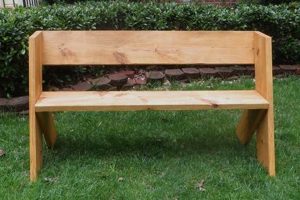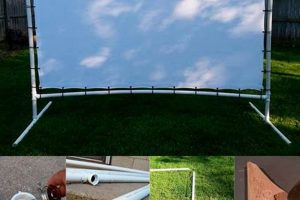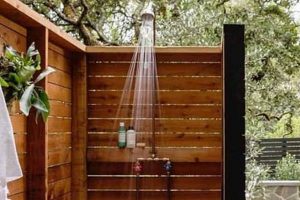A self-assembled heating system, typically located outside a structure, relies on a combustion chamber to burn wood. The heat generated is then transferred to air, which is subsequently propelled through ducts into the building intended for heating. This system offers an alternative approach to conventional indoor heating methods.
Constructing such a system can potentially reduce reliance on traditional fossil fuels, offering a degree of energy independence. Historically, wood-burning furnaces provided a primary heat source in many regions, and adapting this principle for contemporary use allows for utilization of a renewable resource, provided sustainable harvesting practices are employed. Moreover, locating the furnace outdoors mitigates some indoor air quality concerns associated with wood combustion.
The following discussion will delve into critical considerations for design, construction, and safe operation, encompassing factors such as material selection, efficient heat transfer mechanisms, and adherence to relevant safety codes and regulations. A comprehensive understanding of these aspects is paramount for the successful implementation of this heating approach.
Essential Considerations for Assembling an External Wood-Fueled Forced Air Heating System
Careful planning and execution are crucial for safe and efficient operation of an external wood-fueled forced air heating system. These guidelines highlight vital areas that require attention during the design and construction phases.
Tip 1: Firebox Material Selection: Employ high-gauge steel designed for elevated temperatures. Inadequate material selection can result in premature degradation, compromising structural integrity and safety. Verify the steel grade is suitable for continuous exposure to the temperatures anticipated within the firebox.
Tip 2: Heat Exchanger Design: Optimize heat transfer through a meticulously designed heat exchanger. Maximize surface area exposure to the heated air stream while ensuring efficient flue gas venting. Improper design diminishes efficiency and increases the risk of incomplete combustion.
Tip 3: Ductwork Insulation: Insulate all ductwork extending from the unit to the structure thoroughly. Heat loss during transit reduces overall system efficiency. Utilize high R-value insulation suitable for outdoor environments and secure it properly to prevent displacement.
Tip 4: Combustion Air Control: Implement a controlled air intake system. Precise adjustment of air supply enables efficient combustion and minimizes smoke production. Consider an automated damper system linked to a temperature sensor for optimal regulation.
Tip 5: Safety Clearances: Maintain adequate safety clearances from combustible materials. Strict adherence to recommended distances reduces the risk of fire hazards. Consult local building codes to confirm clearance requirements.
Tip 6: Weather Protection: Shield the unit from the elements with a robust, weatherproof enclosure. Exposure to rain, snow, and wind accelerates corrosion and component degradation. A well-constructed shelter significantly extends the lifespan of the system.
Tip 7: Regular Maintenance: Establish a routine maintenance schedule. Regular inspection and cleaning of the firebox, heat exchanger, and flue contribute to prolonged operational efficiency and safety. Neglecting maintenance increases the risk of malfunction and potential hazards.
Implementing these considerations ensures a more reliable, efficient, and safe operation, which leads to an effective alternative heating solution.
The subsequent section will examine practical applications and real-world performance data associated with this type of system.
1. Material Selection
Material selection is a critical determinant of performance and longevity in a self-assembled, external wood-fueled forced air heating system. The combustion chamber, in particular, is subjected to intense heat cycling and corrosive byproducts of wood combustion. Use of inadequate materials leads to premature failure, compromising the system’s integrity and potentially creating safety hazards. For example, utilizing mild steel, which is not designed for sustained high-temperature exposure, will result in warping, cracking, and eventual burn-through, necessitating costly repairs or complete system replacement. The choice of materials directly influences the efficiency and safety of the heating process.
A suitable material for the firebox is high-temperature alloy steel or thick-gauge carbon steel specifically designed for boiler applications. These materials exhibit superior resistance to thermal stress and oxidation, extending the lifespan of the combustion chamber. Furthermore, the selection of appropriate insulation materials for the exterior of the firebox and ductwork minimizes heat loss, improving the overall efficiency of the system. The heat exchanger material also plays a significant role; copper or stainless steel offer excellent heat transfer properties and corrosion resistance, enhancing the system’s capacity to efficiently deliver heat to the structure.
In conclusion, informed material selection is fundamental to the success of constructing an external wood-fueled forced air heating system. The initial investment in appropriate, high-quality materials translates to reduced maintenance costs, improved operational efficiency, and a significantly enhanced margin of safety. Neglecting this crucial aspect can lead to compromised performance, increased risks, and a shortened lifespan for the entire heating apparatus.
2. Combustion Efficiency
Combustion efficiency is paramount in the design and operation of any external, self-assembled wood-fueled forced air heating system. It directly impacts fuel consumption, heat output, environmental impact, and system longevity. Optimizing combustion minimizes wasted fuel, reduces emissions, and maximizes the amount of usable heat generated from each wood charge. This efficiency is not merely a desirable attribute, but a critical factor for effective and sustainable operation.
- Air-to-Fuel Ratio Management
Maintaining the appropriate air-to-fuel ratio is essential for complete combustion. An insufficient air supply leads to incomplete burning, generating smoke, creosote, and reduced heat output. Conversely, excessive air can cool the firebox, reducing efficiency and increasing fuel consumption. Controlled air intake systems, often utilizing dampers or automated controls, are necessary for precise air-to-fuel ratio management.
- Firebox Design and Insulation
The firebox design directly affects combustion efficiency. A well-designed firebox promotes turbulent mixing of air and fuel, ensuring more complete combustion. Insulating the firebox maintains high temperatures, further promoting efficient burning and reducing heat loss. The geometry of the firebox, including the placement of air inlets and the shape of the combustion chamber, significantly influences the effectiveness of combustion.
- Fuel Type and Moisture Content
The type and moisture content of the wood fuel are significant factors. Seasoned hardwood, with a moisture content below 20%, burns more efficiently than green or softwood. Excess moisture absorbs heat during combustion, reducing firebox temperature and increasing smoke production. Properly storing and drying wood is crucial for achieving optimal combustion efficiency.
- Flue Design and Draft
The flue design and chimney draft are critical for removing exhaust gases and maintaining proper airflow within the firebox. An inadequate draft can lead to backdrafting, smoke leakage, and incomplete combustion. A properly sized and insulated chimney ensures efficient removal of combustion byproducts and promotes consistent airflow, contributing to improved combustion efficiency.
These interconnected factors are vital for optimal combustion efficiency within a self-assembled external wood-fueled forced air heating system. Addressing each aspect carefully leads to reduced fuel consumption, minimized emissions, and a more sustainable and cost-effective heating solution. The cumulative effect of these elements directly impacts the viability and environmental footprint of utilizing wood as a primary heating source.
3. Heat Transfer Rate
Heat transfer rate is a critical parameter governing the performance of any external, self-assembled wood-fueled forced air heating system. It quantifies the amount of thermal energy effectively conveyed from the combustion process to the air stream intended for heating a structure. A high heat transfer rate translates directly to greater system efficiency, reduced fuel consumption, and improved heating capacity. Maximizing this rate is, therefore, a primary design objective.
- Heat Exchanger Surface Area
The surface area of the heat exchanger directly influences the heat transfer rate. A larger surface area provides more contact points for thermal energy to be conducted from the hot flue gases to the air stream. Increasing the surface area, through the use of finned tubes or other extended surface designs, enhances the rate of heat transfer. This is typically balanced against practical constraints such as space limitations and manufacturing complexity in the context of external, self-assembled systems.
- Material Thermal Conductivity
The thermal conductivity of the heat exchanger material significantly impacts heat transfer. Materials with high thermal conductivity, such as copper or aluminum, facilitate faster and more efficient heat transfer compared to materials with lower conductivity, such as steel. Selecting a material with appropriate thermal properties is essential for maximizing heat exchange efficiency. The cost and durability must also be considered when selecting a material for a self-built system.
- Airflow Rate and Distribution
The rate at which air flows through the heat exchanger, along with its distribution pattern, affects the heat transfer rate. Higher airflow rates increase the rate of heat removal from the heat exchanger, but can also decrease the amount of time the air is in contact with the heated surfaces, potentially reducing the overall temperature increase. Proper air distribution ensures uniform heat transfer across the heat exchanger surface, preventing localized hot spots and maximizing efficiency.
- Temperature Differential
The temperature difference between the hot flue gases and the air stream is a driving force for heat transfer. A larger temperature differential results in a higher heat transfer rate. Optimizing the combustion process to achieve high flue gas temperatures and minimizing heat loss before the heat exchanger are essential for maximizing this differential. The temperature of the incoming air also plays a role, with colder air allowing for a greater temperature difference.
These elements collectively dictate the heat transfer rate of a self-assembled, external wood-fueled forced air heating system. Careful consideration of each factor is critical for achieving optimal system performance, minimizing fuel consumption, and ensuring effective and reliable heating. These factors must also be weighed against the practical constraints and resources available when undertaking a self-build project.
4. Weather Protection
Weather protection is an indispensable element in the successful implementation of a self-assembled, external wood-fueled forced air heating system. Placement outdoors exposes the entire apparatus to a range of environmental stressors, including precipitation, temperature fluctuations, and ultraviolet radiation. Without adequate shielding, these factors induce accelerated corrosion, component degradation, and operational inefficiencies. A direct consequence of inadequate weather protection is a shortened lifespan for the entire system, necessitating premature repairs or replacement. For instance, exposed electrical components are vulnerable to moisture intrusion, leading to malfunctions and potential safety hazards. Similarly, unprotected steel surfaces are susceptible to rust, weakening structural integrity over time.
Effective weather protection strategies encompass several key elements. A robust, weatherproof enclosure is paramount to shield the furnace from direct exposure to rain, snow, and sun. The enclosure should be constructed from durable materials resistant to corrosion and UV degradation, such as galvanized steel or treated wood. Ventilation must be incorporated to prevent moisture buildup within the enclosure, which could exacerbate corrosion. Furthermore, insulation of the enclosure contributes to thermal stability, minimizing temperature fluctuations and reducing stress on the furnace components. A practical example includes designing the enclosure with an overhang to deflect rainwater and incorporating screened vents to promote airflow while preventing insect or rodent intrusion.
In conclusion, weather protection is not merely an ancillary consideration, but a fundamental requirement for the reliable and long-lasting operation of an external wood-fueled forced air heating system. By prioritizing robust weatherproofing measures, the system’s lifespan is extended, maintenance requirements are reduced, and operational safety is enhanced. This proactive approach mitigates the detrimental effects of environmental exposure, ensuring a sustainable and efficient heating solution. The initial investment in proper weather protection ultimately translates to long-term cost savings and enhanced system performance.
5. Safety Clearances
The establishment and maintenance of adequate safety clearances are non-negotiable prerequisites for the safe and reliable operation of any self-assembled, external wood-fueled forced air heating system. These clearances, defined as the minimum permissible distances between the furnace and any combustible materials, serve as a critical barrier against the risk of fire. Adherence to prescribed clearances is not merely a recommendation but a mandatory safety protocol.
- Minimum Distance to Combustible Structures
The primary function of safety clearances is to prevent the ignition of nearby structures or materials. Combustible materials, such as wood siding, fences, or vegetation, must be located at a specified distance from the furnace’s external surfaces and flue. Failure to maintain these distances can result in radiant heat igniting the combustible material, leading to a structural fire. Local building codes typically stipulate minimum clearance requirements, which must be strictly observed. For instance, a code may mandate a 10-foot clearance from any wood structure and a 20-foot clearance from an overhang.
- Flue Clearance and Spark Arrestors
The flue, or chimney, is a significant source of heat and potential sparks. Flue clearances are essential to prevent ignition of nearby roofing materials, trees, or other combustibles. In addition to maintaining minimum distances, the installation of a spark arrestor is crucial to contain embers and prevent them from being carried by the wind and igniting distant materials. Regular inspection and cleaning of the spark arrestor are necessary to ensure its effectiveness. An example would be ensuring the flue is at least three feet higher than any part of a roof within ten feet, and fitting a tested spark arrestor.
- Ground Clearance and Support Structure
Ground clearance refers to the vertical distance between the bottom of the furnace and the ground. This clearance prevents heat from being conducted to the ground, potentially igniting dry vegetation or other combustible materials. The furnace should be supported by a non-combustible base, such as concrete or brick, to ensure stability and maintain adequate ground clearance. For instance, placing the furnace directly on dry grass poses a significant fire risk.
- Clearance for Fuel Storage
Wood fuel storage areas should be located at a safe distance from the furnace to prevent accidental ignition of the fuel pile. Heat radiation or stray sparks from the furnace can ignite dry wood, leading to a larger fire. Maintaining a substantial clearance between the furnace and the woodpile minimizes this risk. A practical measure includes storing wood at least 30 feet away from the furnace and ensuring the woodpile is clear of vegetation.
In conclusion, rigorous adherence to safety clearance requirements is an indispensable component of the safe operation of a self-assembled, external wood-fueled forced air heating system. These clearances provide a vital buffer against the potential for fire, protecting property and lives. Consulting local building codes, adhering to manufacturer’s recommendations, and exercising common sense are essential for establishing and maintaining adequate safety clearances. Neglecting this critical aspect can have catastrophic consequences.
6. Maintenance Protocols
Consistent and thorough maintenance is paramount to the safe, efficient, and prolonged operation of a self-assembled, external wood-fueled forced air heating system. Neglecting routine maintenance procedures precipitates component failures, reduces heating efficiency, and elevates the risk of hazardous conditions. Therefore, adherence to a comprehensive maintenance protocol is not optional but integral to the successful utilization of this heating approach.
- Firebox Inspection and Cleaning
The firebox is subjected to extreme thermal stress and corrosive byproducts of combustion. Regular inspection for cracks, warping, or corrosion is essential. Creosote buildup, a highly flammable byproduct of incomplete combustion, must be removed periodically to prevent chimney fires and maintain optimal draft. Example: A bi-weekly inspection for creosote accumulation coupled with monthly cleaning using a chimney brush.
- Heat Exchanger Cleaning
Soot and ash accumulation on the heat exchanger surfaces impede heat transfer, reducing system efficiency. Periodic cleaning ensures optimal heat transfer rates and maximizes the amount of heat delivered to the structure. Example: Cleaning the heat exchanger fins with a wire brush or vacuum attachment every two months to remove accumulated debris.
- Flue and Chimney Inspection and Cleaning
The flue and chimney are critical for venting combustion gases safely. Regular inspection ensures structural integrity and proper draft. Creosote buildup in the chimney poses a significant fire hazard and must be removed periodically. Example: An annual professional chimney sweep to inspect and clean the entire venting system.
- Air Intake and Blower Maintenance
Proper airflow is essential for efficient combustion and heat distribution. Inspection and cleaning of air intakes ensures unrestricted airflow. Lubrication of blower motor bearings maintains optimal blower performance. Example: Cleaning air intakes of debris and lubricating blower motor bearings annually with high-temperature grease.
These maintenance facets are interconnected and contribute significantly to the overall performance and safety of a self-assembled external wood-fueled forced air heating system. Consistent application of these protocols mitigates the risk of component failures, ensures efficient heat delivery, and safeguards against fire hazards, extending the system’s useful life and maximizing the return on investment.
Frequently Asked Questions
The subsequent questions address common concerns and misconceptions surrounding the design, construction, and operation of self-assembled, external wood-fueled forced air heating systems.
Question 1: Are self-constructed outdoor wood furnaces legal in all jurisdictions?
Regulations regarding the operation of outdoor wood-fired furnaces vary significantly by locality. Some municipalities have outright bans, while others impose strict emission standards and setback requirements. Prior to commencing construction, consult local and state environmental protection agencies to ascertain compliance with all applicable regulations. Operation in violation of established codes can result in fines and legal action.
Question 2: What is the expected lifespan of a DIY outdoor wood furnace?
The longevity of a self-constructed outdoor wood furnace is directly correlated with the quality of materials employed, the adherence to sound engineering principles, and the consistency of maintenance practices. Systems built with inferior materials or lacking proper weather protection are prone to premature failure. Conversely, well-designed and maintained systems can achieve a lifespan of 10-15 years, provided that rigorous maintenance protocols are followed.
Question 3: What safety precautions must be observed during operation?
Operating a wood-fired furnace necessitates strict adherence to safety protocols. Maintain adequate clearances from combustible materials to mitigate fire hazards. Install and regularly inspect a spark arrestor to prevent the spread of embers. Never leave the furnace unattended while in operation. Ensure proper ventilation to prevent carbon monoxide accumulation. Store wood fuel away from the furnace to avoid accidental ignition.
Question 4: How can combustion efficiency be maximized?
Optimizing combustion efficiency requires careful attention to several factors. Utilize seasoned hardwood with a moisture content below 20%. Regulate air intake to achieve a balanced air-to-fuel ratio. Insulate the firebox to maintain high combustion temperatures. Clean the flue regularly to prevent creosote buildup. Proper combustion minimizes fuel consumption and reduces emissions.
Question 5: Can an existing ductwork system be used with an outdoor wood furnace?
Integration with an existing ductwork system is possible, but requires careful consideration. The ductwork must be adequately sized to handle the airflow requirements of the furnace. Proper insulation is essential to minimize heat loss during transit. A qualified HVAC technician should inspect the ductwork to ensure compatibility and safety.
Question 6: What are the potential environmental impacts of burning wood?
Wood combustion releases particulate matter, carbon monoxide, and other pollutants into the atmosphere. While wood is a renewable resource, unsustainable harvesting practices can lead to deforestation. Operate the furnace efficiently and utilize dry, seasoned wood to minimize emissions. Consider investing in emission control technologies, such as catalytic combustors, to further reduce environmental impact.
In summation, the successful and safe operation of a self-assembled outdoor wood furnace hinges on meticulous planning, sound construction practices, and diligent adherence to maintenance and safety guidelines.
The subsequent section will provide resources and further reading on this subject.
DIY Outdoor Forced Air Wood Furnace
This discussion has explored the critical factors involved in constructing and operating a diy outdoor forced air wood furnace. Key points included material selection, combustion efficiency, heat transfer rate optimization, robust weather protection, adherence to stringent safety clearances, and the implementation of regular maintenance protocols. Each element contributes significantly to the system’s overall performance, longevity, and safety profile.
The decision to implement a diy outdoor forced air wood furnace necessitates a thorough understanding of its inherent complexities and potential challenges. Careful consideration of regulatory compliance, environmental impact, and ongoing operational demands is paramount. Responsible implementation, guided by informed decision-making, is essential to ensure the safe, efficient, and sustainable utilization of this alternative heating solution. Independent verification with qualified experts before making any practical actions is advised.







